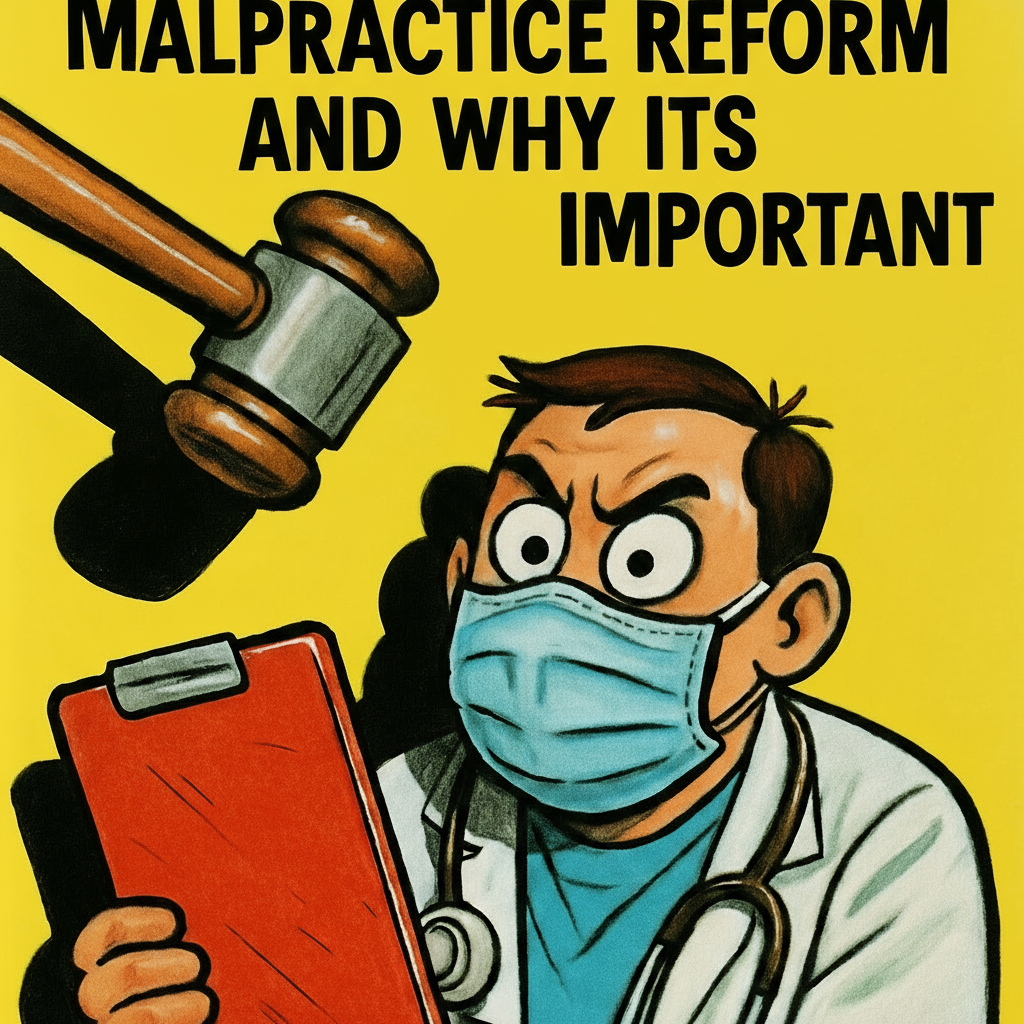
Why Malpractice Reform Is Essential for Healthcare Sustainability
Doug Jorgensen
March 15, 2025
Introduction: The Elephant in the Exam Room
When we talk about the high cost of healthcare, we often point to drug prices, hospital charges, or insurance premiums.
But there’s another major factor quietly driving costs and shaping physician behavior: the malpractice system.
Without reform, the current liability environment will continue to inflate costs, distort medical decision-making, and discourage physicians from practicing in high-need areas.
The Problem With the Current System
The US malpractice system was designed to:
- Compensate patients harmed by medical negligence.
- Hold providers accountable for substandard care.
In practice, it often:
- Rewards litigation over resolution.
- Encourages “jackpot” jury awards unrelated to actual damages.
- Forces providers to practice defensive medicine.
- Increases malpractice insurance premiums—especially in certain specialties and states.
The Ripple Effect on Healthcare Costs
High liability risk leads to:
- Defensive Medicine – Ordering unnecessary tests and procedures to avoid lawsuits.
- Higher Insurance Premiums – Especially in obstetrics, neurosurgery, and emergency medicine.
- Geographic Shortages – Physicians leaving or avoiding high-risk states or specialties.
- Reduced Access – Some hospitals close high-liability departments like maternity wards.
The Human Toll on Providers
The stress of potential litigation can:
- Shorten careers through burnout.
- Lead physicians to avoid complex or high-risk cases.
- Deter young doctors from entering high-liability specialties.
For many, the constant legal threat undermines professional satisfaction and drives early retirement. A colleague and friend, after winning the only lawsuit of his 30-year career, told me he would stop practicing medicine if he ever had to endure such an experience again.
What Effective Malpractice Reform Looks Like
1. Caps on Non-Economic Damages
A balanced approach to malpractice reform would cap non-economic damages like pain and suffering, while fully compensating economic losses. Ideally, this would be achieved through federal legislation, though state-by-state protections are also necessary. However, achieving such reform is challenging due to the influence of lawyers and lobbyists who benefit from the current system. While malpractice compensation has its place, the overly litigious nature of our society creates an adversarial environment.
2. Safe Harbor Laws
While adherence to accepted guidelines and standards can prevent most complications and adverse events, some variables remain unknown, and certain procedures are inherently high-risk. In such cases, even extensive informed consent may not alleviate distress if an unexpected event occurs. Therefore, clear protections are necessary to state and limit liability, provided that the standard of care was maintained and thoroughly documented. Moreover, defensive medicine leads to unnecessary procedures and testing, an unfortunate truth. Protections against malpractice reduce such wasteful spending.
M3. Specialized Health Courts
More efficient resolution of cases can be achieved by utilizing expert panels or judges with medical expertise. Maine exemplifies this with its pre-litigation screening panels, which consist of a doctor, a lawyer, and a judge. This three-person board hears arguments from both the plaintiff and defense, then determines if malpractice occurred or if it was simply an unfortunate outcome. This approach has led to reduced malpractice premiums and discourages frivolous lawsuits.
4. Early Disclosure and Settlement Programs
Mistakes are an unavoidable part of human endeavor, even in healthcare. While systems and protocols are designed to minimize errors, providers should be encouraged to admit mistakes and offer prompt compensation to patients, bypassing lengthy litigation. Research indicates that a simple apology, such as “I’m really sorry this happened,” can significantly reduce patient anger and desire for retribution. However, defense lawyers and malpractice insurers often interpret such expressions not as empathy, but as an admission of guilt.
5. Screening Panels
Malpractice reform is crucial for healthcare sustainability. It should protect physicians who adhere to evidence-based clinical guidelines from liability, acknowledging that good medical practice can sometimes lead to undesirable outcomes. There are uncontrollable variables in medicine that affect doctors, hospitals, and patients alike. Penalizing appropriate clinical care perpetuates defensive medicine and exacerbates provider burnout. These panels directly engage both sides, offering protection to providers, but their implementation requires action from each state legislature.
The Political and Legal Barriers
Malpractice reform is a politically charged issue, with strong lobbying from:
- Trial lawyer associations opposing caps and limits.
- Medical associations pushing for liability protections.
Because lawmakers protect their colleagues, and malpractice carriers and medical societies protect their clients and colleagues, progress in malpractice reform varies significantly by state. Common-sense reform requires finding a middle ground.
The Patient Perspective
Critics of reform worry that it could reduce accountability and harm patients’ ability to seek justice.
The reality is that an overloaded, adversarial malpractice system isn’t serving patients well either—it’s slow, costly, and unpredictable.
Well-designed reform should:
- Preserve patient rights.
- Ensure fair compensation for genuine harm.
- Reduce unnecessary costs that ultimately get passed back to patients.
Final Thoughts: A Necessary Step for Sustainability
Malpractice reform isn’t about shielding bad doctors—it’s about creating a fair, efficient system that:
- Compensates injured patients.
- Encourages safe, evidence-based care.
- Reduces the waste and fear that drive up costs.
If we want a sustainable healthcare system, we can’t ignore the legal environment it operates in.
About the Author
Douglas J. Jorgensen, DO, CPC, FAAO, FACOFP
Dr. Doug is a physician, consultant, and national educator on healthcare policy and regulatory compliance. He works with healthcare organizations and policymakers to promote patient safety while advocating for common-sense legal reform.


